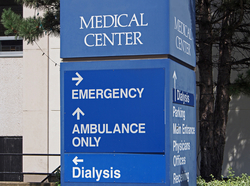Action Points
Only about one in four patients with end-stage renal disease in Georgia were referred for kidney transplant evaluation by their dialysis facility from 2005 to 2011, according to a study published in the Journal of the American Medical Association.
Of those referred, only about one in five made it onto the national deceased-donor waiting list, reported lead investigator Rachel Patzer, PhD, of Emory University in Atlanta, and colleagues.
"For most of the 600,000 patients in the United States with end-stage renal disease (ESRD), kidney transplantation represents the optimal treatment, providing longer survival, better quality of life, and substantial cost savings compared with dialysis," Patzer and colleagues wrote.
"Despite these benefits, kidney transplantation is not available to all patients with ESRD, owing to the paucity of available organs, as well as long-standing racial/ethnic, socioeconomic, sex, age, and geographic disparities in access to kidney transplantation," the investigators said in the report.
A referral for evaluation at a transplant center is usually required to begin the transplantation process, but the proportion of patients referred in the United States is unknown. There is no source of national data on referral rates, Patzer told MedPage Today.
Patzer and colleagues decided to investigate referral rates in Georgia, the state with the lowest kidney transplantation rate, in order to shed some light on this issue. "This study is unique because no one has ever looked at data on this level before," Patzer said.
The investigators collected data on more than 15,000 adult patients with ESRD at 308 Georgia dialysis facilities from 2005 to 2011. The data were obtained from the United States Renal Data System. The researchers then linked this information to kidney transplant referral data collected from transplant centers in Georgia during the same time period.
The study found that 28% of the ESRD patients were referred for transplantation within one year of starting dialysis. Referral rates varied widely across dialysis centers, from 0% to 75%. The median within-facility percent of patients referred was 24%.
Compared with dialysis facilities with the highest rates of referral, those with the lowest rates were more likely to treat patients from high-poverty neighborhoods (absolute difference 21.8%; 95% CI 14.1% to 29.4%; P<0.001), to have a higher patient to social worker ratio (mean 61.2 versus 38.8; P<0.001), and to be non-profit (difference 17.6%; 95% CI 7.7% to 27.4%; P=0.001).
Patients not referred were more likely to be older (difference 5.7 years; 95% CI 5.3 to 6.1; P<0.001), to be white (absolute difference 5%; 95% CI 3.4% to 6.6%; P<0.001), and to be female (difference, 3.8%; 95% CI 2.1% to 5.6%; P<0.001).
Of the patients referred, 21.5% were put on the donor waiting list within one year of their referral. The factors associated with referral were often not the same as those associated with being waitlisted, the researchers noted. For example, sex and age were not significantly associated with waitlisting, and black patients (versus white) were less likely to be waitlisted (OR 0.77; 95% CI 0.64 to 0.93; P not reported).
"These finding may have implications for health policy makers, researchers, clinicians, and patients. Low facility level referral for transplantation, as well as the variability in referral across Georgia facilities, suggests that standardized guidelines are needed for the content and duration of a patient-clinician educational discussion regarding treatment options at start of dialysis," the researchers concluded.
"The 28% figure seemed low to us," Patzer told MedPage Today. "There aren't any absolute contraindications to transplant. Given that transplant is the best treatment option, we would think the majority of patients would be referred."
Having more patients referred and put on the waiting list for transplant would not necessarily just increase the wait time for a limited supply of donor organs, Patzer argued. "It's not a zero sum game," she said.
For example, eligible patients would have the option of trying to find a living donor among family or friends. And transplant centers might be more aggressive about the organs they select, she said.
"Nephrologists, social workers, and nurses in dialysis facilities should be having conversations with patients about transplant as early as possible. The earlier you can get a referral, the better," Patzer said.
Increasing referral rates may not be enough to ensure better patient outcomes, said transplant surgeon Dorry Segev, MD, PhD, of Johns Hopkins University, and colleagues in an editorial.
"In light of these findings, efforts to improve access should not only focus on improving rates of dialysis center referral for kidney transplantation but also on identifying and targeting barriers for the 80% of referred patients who ultimately did not achieve access," Segev and colleagues wrote.
"These findings underscore the complexities involved in obtaining access to care and should serve as a reminder that it may not be sufficient to provide a referral for care in the absence of guidance and support through the process," they said.
This research was supported by the National Institute on Minority Health and Health Disparities.
The authors disclosed no relationships with industry.
|
 Log in to explore the world's most comprehensive database of dialysis centres for free!
Log in to explore the world's most comprehensive database of dialysis centres for free!  Professional dialysis recruitment
Professional dialysis recruitment





